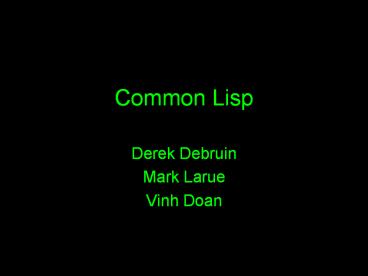Common Lisp - PowerPoint PPT Presentation
Title:
Common Lisp
Description:
The car function yields the 'head' (first element) of a list: (car (1 2 3)) 1 ... form is evaluated when encountered and again when used: (setq a b) (setq b c) ... – PowerPoint PPT presentation
Number of Views:331
Avg rating:3.0/5.0
Title: Common Lisp
1
Common Lisp
- Derek Debruin
- Mark Larue
- Vinh Doan
2
Problem Domains
- There was a need in the early 1960s to define a
programming language whose computational model
could be based on some well characterized
mathematical principles rather than on the
efficiency of implementation. - Lisp become one of the best examples of these
language definitions.
3
John McCarthy
- Lisp was invented by John McCarthy in the late
1950's as a formalism for reasoning about the use
of recursion equations as a model for
computation. - The name Lisp derives from "List Processing
Language". - Of computer languages still in widespread use
today, only FORTRAN is older.
4
McCarthy Cont
- Around 1956 McCarthy understood the central role
of a programming language for his scientific goal
-- artificial intelligence. - McCarthy desired for an algebraic list processing
language for artificial intelligence work on the
IBM 704 computer (1958)
5
Variation in Lisp
- Since the inception of Lisp many variations have
been created. - Of each of these variations, there also has been
many dialects born. - The most widely-known general-purpose Lisp
dialects are Common Lisp and Scheme.
6
Common Lisp
- Rapid was beneficial in early development, but
demand for a standard eventually grew. - Developed to standardize the divergent variants
of Lisp. - It is not an implementation but more of a
language specification.
7
Basic Concepts
- Everything is a list. Everything.
- Language can be redefined at run-time.
- Code is data and can be generated at run-time.
- This is one of the primary reasons that Lisp is
so popular in artificial intelligence.
8
Greenspuns Tenth Rule
- Any sufficiently complicated C or Fortran program
contains an ad-hoc, informally-specified,
bug-ridden, slow implementation of half of Common
Lisp. - Lisp is often considered the Grand-Daddy of them
all. - Many important features of other languages come
from Lisp.
9
Macros
- Not the same as Cs preprocessor macros
- Lisp macros formalize the ability of Lisp to
implement other languages and to change its
defined behavior dynamically.
10
Examples
- The S-expression is the basic syntax of Lisp a
parenthesized list. - (list 1 2 3)The basic definition of a list.
- (cons 1 2) constructs a basic list with contents
(1 2)
11
Examples (cont.)
- The car function yields the head (first
element) of a list (car (1 2 3)) ? 1 - The cdr function yields the tail (everything
following the head) of a list (tail (1 2 3)) ?
(2 3)
12
Examples (cont.)
- Quoting prevents lists from being evaluated
automatically. - (one two three) is a quoted list.
- Quoting prevents the list from being evaluated as
three identifiers one, two, and three.
13
Complete Example
- An unquoted form is evaluated when encountered
and again when used - (setq a b)
- (setq b c)
- (eval a)
- ? c
14
Comparing Lisp to C
- Lisp is a functional programming language C is
procedural. - This causes Lisp and C to have numerous
differences in syntax, function definition,
typing, etc.
15
Prefix Syntax
- Lisp expressions use prefix notation. The
expression - ( l 2 3 4) evaluates to 24.
- The equivalent expression in C would use infix
notation - 1 2 3 4
16
Functions
- Functions are created through the use of the
special operator lambda. - lambda takes an argument list and an expression,
evaluating the arguments according to the
expression. - The expression
- ((lambda (arg) ( arg 2)) 3) describes a
function that takes one argument, 3, and
multiplies it by 2, yielding a result of 6.
17
Functions (cont.)
- Contrast this with C, where a function stores
an argument which is explicitly manipulated by
statements that follow - int lambda( int arg )
- return arg 2
18
Cons and Implicit Typing
- Lisp uses lists as its primary data structure.
- Lists are constructed similarly to other
functional languages, using cons, append, etc. - Data is implicitly typed in list and can
therefore be mixed in a given list. - For example, (cons a (2 3)) evaluates to (a 2 3).
19
Lists and Typing (cont.)
- In C data is explicitly typed.
- C also lacks a primitive list data
structurethe closest equivalent is the array,
which may contain only one data type. The
following code is not valid in C - int list3 a, 2, 3
20
Impact and the Future
- McCarthy pioneered the if-then-else structure
through Lisps cond structure - Lisp has had a resurgence in popularity lately.
- The lack of variables in Lisp causes programs
without side-effects. This may prove very useful
in parallel computing.

